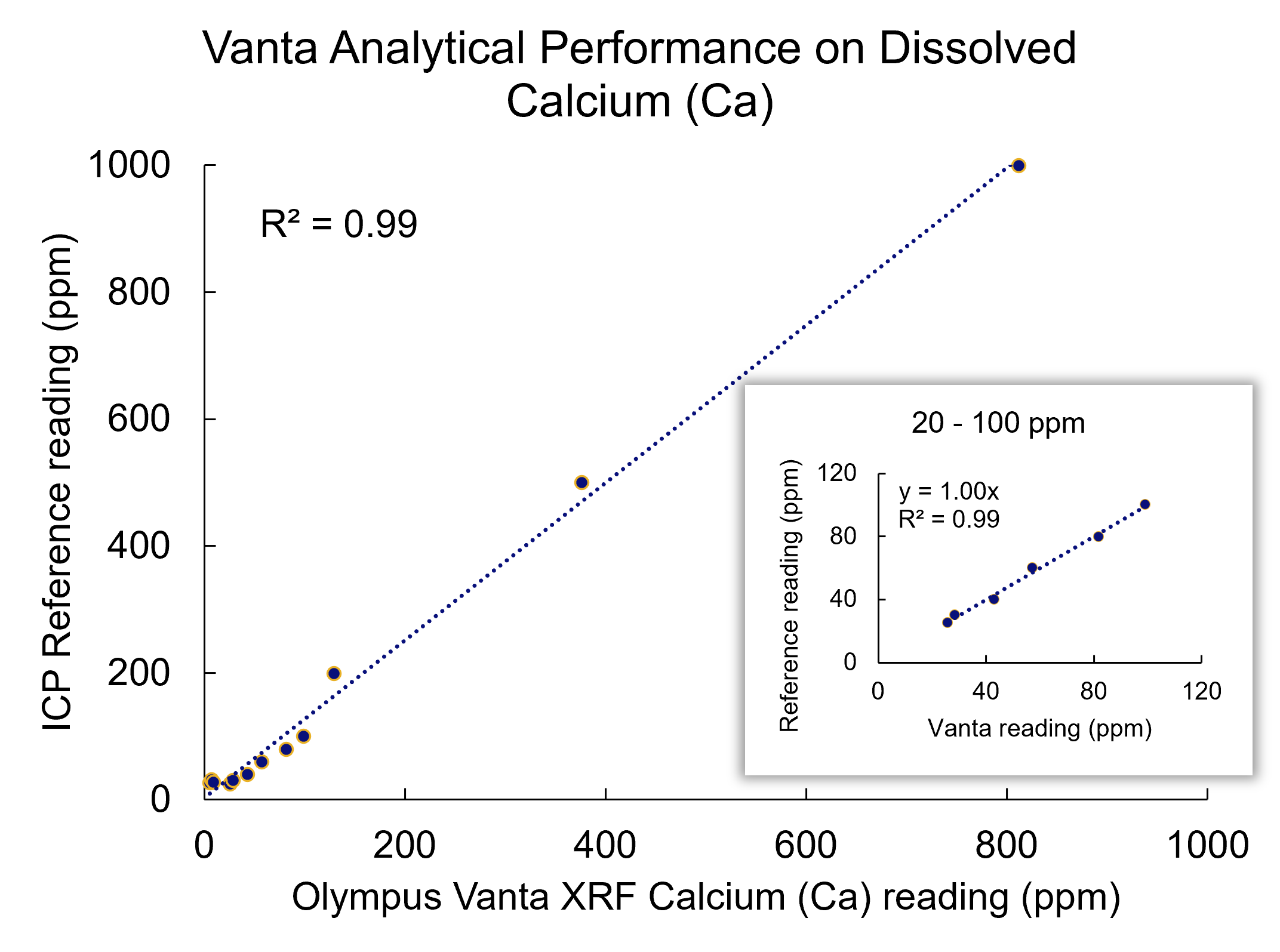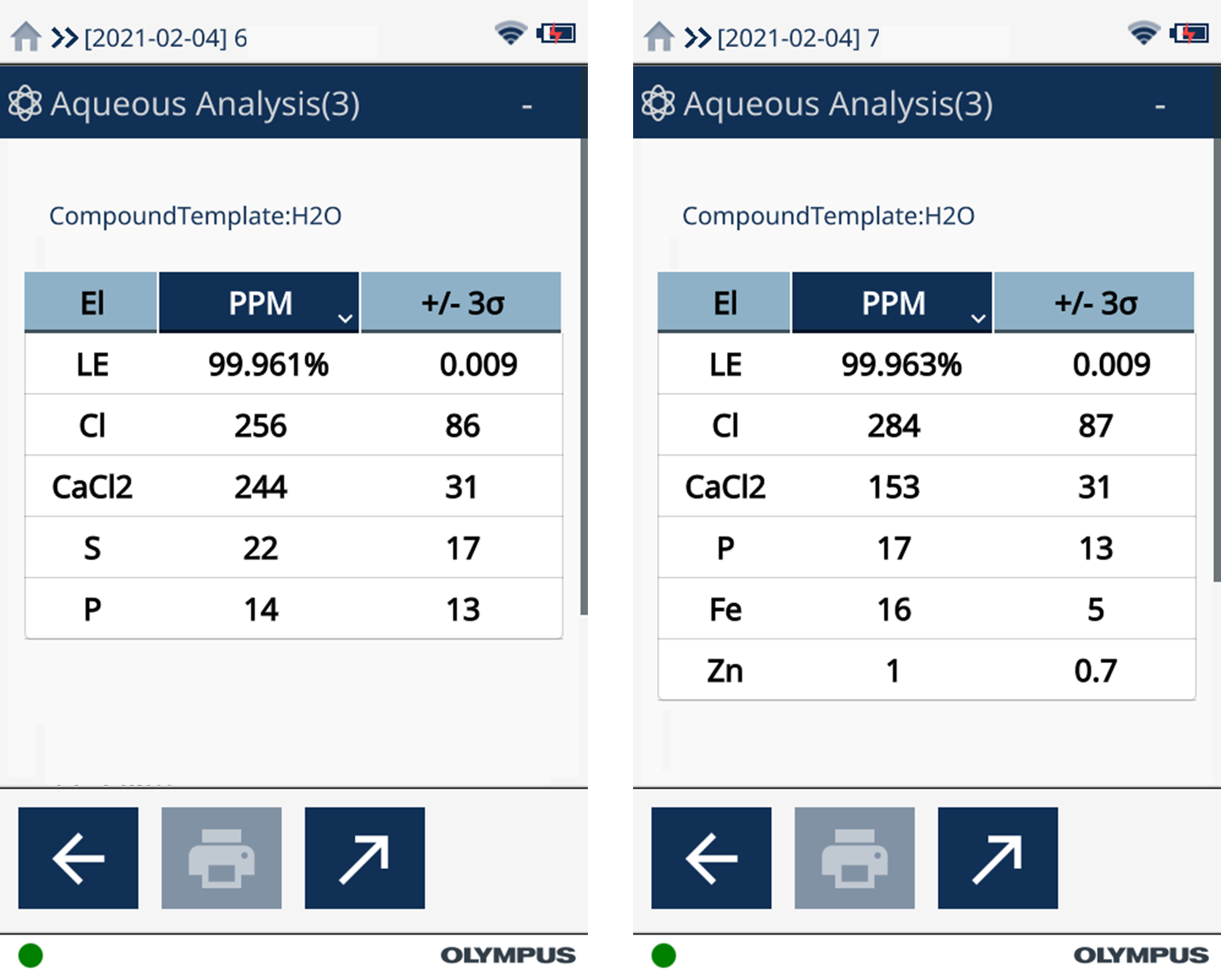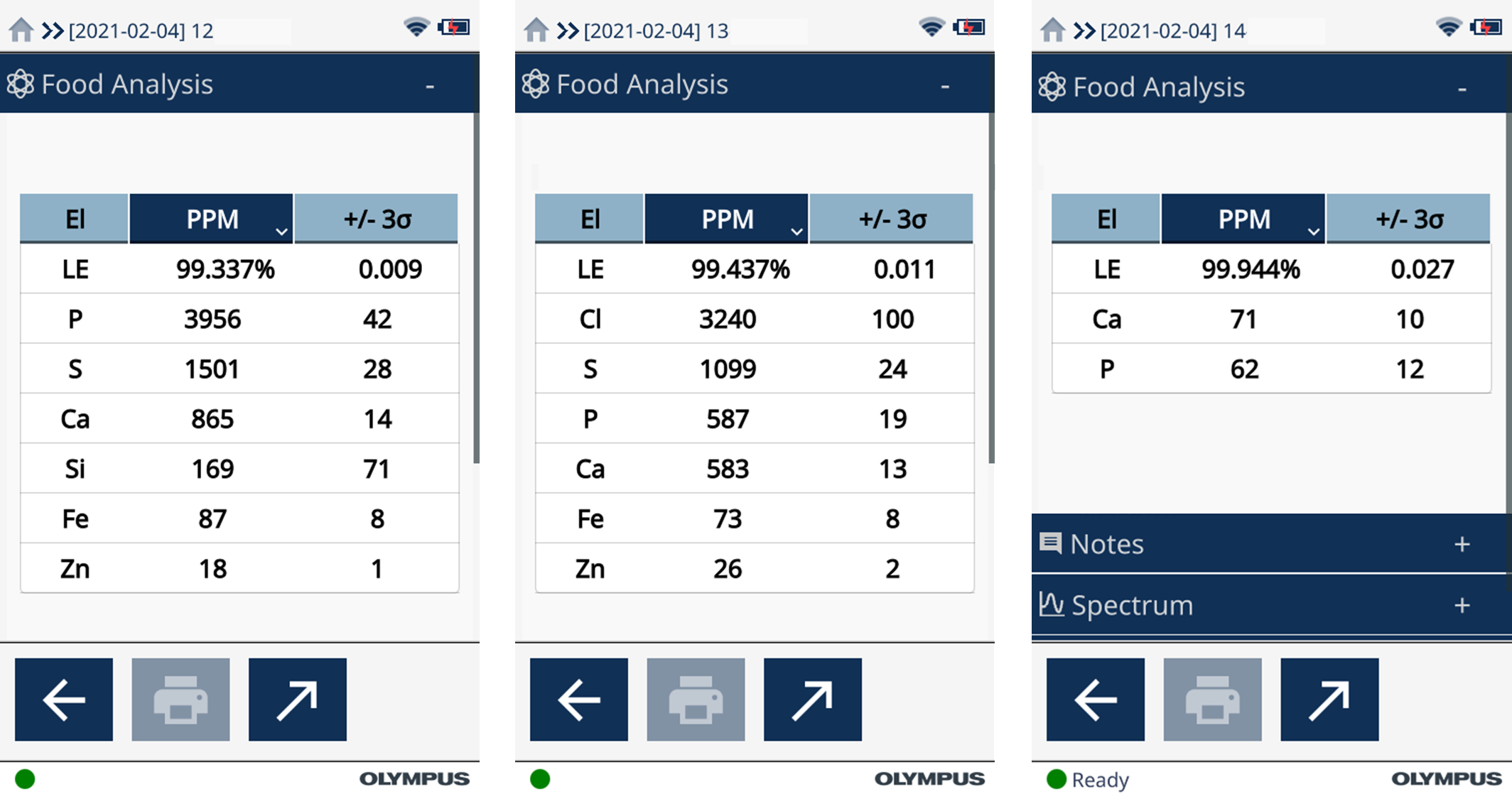Is the water that comes from your tap just H2O? The answer is not that simple; water may contain dissolved materials hidden to the naked eye. Portable X-ray fluorescence (pXRF) instruments, such as Olympus’ Vanta™ handheld XRF analyzer, can help identify hidden minerals and contaminants in your drinking water.
Identifying Minerals and Contaminants in Water
While we may think our drinking water is just H2O, there are often other materials dissolved in your glass. Some of these materials are beneficial to us, such as fluoride, which helps prevent tooth decay. Other common minerals include calcium chloride (CaCl2), an electrolyte-containing compound that, when present in water, can help prevent dehydration. Calcium chloride, along with other common chlorides such as magnesium, sodium, and potassium chloride, can leech into drinking water from rocks through geologic processes. The graph below (Figure 1) shows the precision of the Vanta pXRF analyzer in measuring dissolved calcium from 1000 ppm down to 20 ppm.

Figure 1. Vanta pXRF analytical performance on dissolved calcium against an ICP reference sample (inset showing lower concentrations)
However, water may contain potentially harmful materials, including nitrates (NO3-), manganese (Mn), iron (Fe), and bicarbonate (HCO3-), among others. These elements and compounds can cause various health and infrastructure issues, including harm to pipes and water heaters, scale formation, and bacterial growth.
Elemental analysis techniques, such as portable X-ray fluorescence (pXRF) analysis performed using the Vanta™ series, can be used to identify and quantify some of these harmful materials. pXRF can also help identify heavy metals, one of the largest and most harmful groups of drinking water contaminants.
Heavy Metal Contamination in Drinking Water
Heavy metals, which generally include chromium (Cr), nickel (Ni), copper (Cu), arsenic (As), cadmium (Cd), mercury (Hg), and lead (Pb), can cause various issues when present in drinking water. These metals can get into the water from human and geologic activities, such as the natural weathering of rocks, coal-burning power plants, and mines. When these metals get into groundwater, they can make the water more acidic or alkaline. As a result, the water is potentially toxic for drinking and destructive to pipes and other water infrastructure. By changing the pH of the water, these metals can also encourage the growth of various types of harmful bacteria.
Various Types of Drinking Water
Fortunately, most drinking and potable water has undergone some filtering or other purification processes. We have various types of drinking water readily accessible to us:
- Tap
- Distilled
- Filtered
- Spring
- Purified
Usually the most easily accessible, tap water undergoes a few processes. From groundwater, some chemicals are added that remove dirt and most other dissolved particles. The clear water is then filtered and disinfected with chlorine, with fluorine added in some regions. Distilled water has been boiled, creating steam or water vapor, and then condensed back down into drinkable water, removing almost all contaminants. Filtered water is similar to tap water, although some filtered waters are treated with ozone to kill bacteria prior to bottling with the final purification step. Similar to filtered water, spring water undergoes the purification step that tap water does in addition to an ozone treatment. Lastly, purified water includes many purification techniques, such as reverse osmosis, distillation, and deionization. Each of these techniques removes and leaves certain dissolved materials and contaminants. Using Vanta pXRF analyzers, we can identify which dissolved materials have not been removed from these various types of water.
Analyzing Water Using Vanta pXRF Analyzers
To show you how pXRF works, we tested the five previously mentioned types of water along with some rainwater using a Vanta analyzer, then quantitatively analyzed the results. The test took one minute, enabling us to quickly identify the contaminants and minerals in water (Figure 2).
| Sample | Phosphorous (P) | Sulfur (S) | Chlorine (CI) | Calcium (Ca) | Iron (Fe) | Zinc (Zn) |
|---|---|---|---|---|---|---|
| Distilled | ||||||
| Purified | ||||||
| Spring | 14 ppm | 22 ppm | 256 ppm | 88 ppm | ||
| Filtered | 27 ppm | 220 ppm | ||||
| Tap | 17 ppm | 285 ppm | 55 ppm | 16 ppm | 1 ppm |
Figure 2. Vanta pXRF analysis of five water types shows a range of dissolved materials
While all the water types look the same using visual inspection, the samples contain different dissolved materials. The waters that undergo many purification steps, such as distilled water and purified water, contain no detectable levels of dissolved minerals, salts, or metals. Waters that are closer to the source, such as spring and filtered water, contain some elements from organic materials, such as phosphorous and sulfur, as well as salts from geologic processes, such as calcium and chlorine. Tap water, in addition to containing these organic materials and salts, have trace (and still safe) iron and zinc from some of the pipes that transport the water. This iron can be used by your body as a needed mineral but can also leave reddish stains on water fixtures in your house. Fortunately, none of the tested water types had any detectable amounts of heavy metals.
In addition to calculating elemental concentrations, the Vanta™ pXRF analyzer can calculate the concentration of various salts. Using our spring and tap water as an example, the Vanta analyzer can determine the concentration of calcium chloride inline in real time (Figure 3).

Figure 3. Inline calculation by the Vanta pXRF analyzer of calcium chloride (CaCl2) on spring water (left) and tap water (right)
Identifying Heavy Metal Contaminants in Wastewater
The Vanta™ pXRF analyzer can also identify heavy metal contamination in wastewater or water used for industrial and agricultural purposes. While some of these heavy metals may be directly detectable by the Vanta analyzer at 1 ppm (1 mg/L) or above, some contaminates exist below that level. Advances in sample preparation, such as the time-lapse ion exchange resin sachets (TIERS)1, enable the Vanta analyzer to detect heavy metal and salt concentrations down to the part per billion (ppb) level, or fractions of 1 mg/L. This simple and inexpensive sample preparation technique can amplify concentrations in water by 100 to 1000 times, enabling limits of detection that rival more expensive techniques.
Using TIERS or other ion-exchange resins has shown to aid in the detection of illegal discharge in industrial and agricultural waters1, assessment of heavy metal pollution in farmland2, and identification of pollutants in larger bodies of water3. These techniques have led to the development of wastewater fingerprinting, enabling researchers to identify where specific pollutants or contaminants came from. The ability to achieve ppb detection limits with pXRF makes it a useful tool for wastewater analysis and contaminant identification.
Contaminants in Food and Drinks
Water is not the only food or drink that may contain heavy metal contamination. Other commonly consumed items, such as grains and sugar, can be contaminated with heavy metals as well. In addition to identifying full metal pieces in food, trace metals from human and environmental activities can also contaminate food. Metals, such as iron and zinc, can be accidentally added to foods through the breakdown of machine equipment, pollutants in fertilizers, and various milling and processing techniques. Contaminants can be added to sugar through contaminated water used in processing and contaminants present in the soil that grew the sugar cane. Similar to testing water, we tested consumer-grade flour, rice, and sugar with a Vanta™ pXRF instrument and quantitatively analyzed the results. The test took one minute, quickly providing us with the contamination in these common pantry supplies (Figure 4).

Figure 4. Vanta pXRF analyzer scans of common foods, including sugar (left), flour (middle), and rice (right).
While none of the dissolved materials are visible to the naked eye, they are clearly present in these foods. All detected elements are naturally occurring in these materials, coming from naturally occurring minerals, salts, and nutrients. The Vanta analyzer can even be used to test products as diverse as protein powders or cannabis.
These elemental analyses clearly reveal contamination in consumer foods and drinks, demonstrating the analytical performance of Vanta handheld XRF analyzers.


